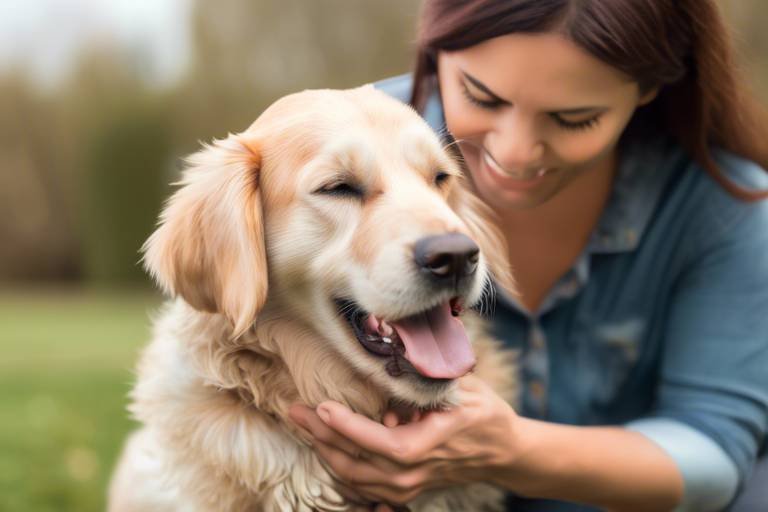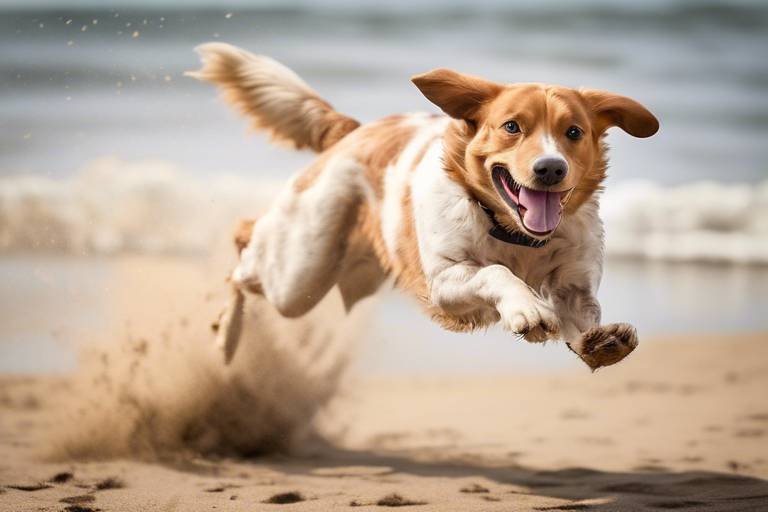How to Help Your Pet Adjust to a New Routine
Transitioning your furry friend to a new routine can feel like trying to teach a cat to fetch—challenging, yet incredibly rewarding when done right! Pets thrive on familiarity, and when their daily lives change, they can become anxious or confused. Whether you're moving to a new home, starting a new job, or simply altering their feeding schedule, it’s essential to approach these changes thoughtfully. By implementing effective strategies, you can help your pet feel secure and comfortable, ensuring a smoother transition that maintains their well-being and happiness.
First things first, understanding how your pet reacts to change is crucial. Just like humans, pets have their own unique personalities, and their responses can vary widely. Some may exhibit signs of stress, such as excessive barking, hiding, or even changes in appetite, while others might seem unfazed. Observing these behaviors can provide valuable insights into their emotional state. For instance, if your dog suddenly becomes clingy or your cat starts to hide, it’s a signal that they might need a little extra reassurance. By tuning into their feelings, you can offer the support they need during this adjustment period.
One of the most effective ways to help your pet adapt is by establishing a consistent daily routine. Think of it like giving them a cozy blanket of predictability to snuggle into. A reliable schedule can significantly reduce anxiety, making it easier for them to embrace changes in their environment. This routine can encompass various aspects of their day, including feeding times, exercise, and playtime. By sticking to a regular schedule, you send a clear message to your pet that everything is okay, even when other aspects of their life are shifting.
Imagine how you feel when your meal times are all over the place—confusing, right? The same goes for your pet. Keeping feeding times consistent can significantly impact their sense of stability. When they know when to expect their meals, it can help them adjust to new routines more comfortably. So, if you're changing their feeding schedule, try to do it gradually. For example, if you need to shift their dinner time from 6 PM to 7 PM, do it in 15-minute increments over several days. This way, they won't feel like their whole world has been turned upside down.
Choosing the right food is also essential. Just like you wouldn’t want to switch from your favorite pizza to a bland salad overnight, your pet deserves a diet that suits their needs, especially during routine changes. Look for high-quality food that provides the nutrients necessary for their energy and happiness. If you're considering a switch in food, do it gradually to avoid stomach issues. Mix a little of the new food with their current diet and increase the new food over a week or two.
Monitoring portion sizes during meal times is crucial, especially when routines change and activity levels may vary. Overfeeding can lead to weight gain, while underfeeding can leave them feeling sluggish. It’s like trying to run a marathon on an empty stomach! Consult with your vet about the appropriate portion sizes based on your pet's age, weight, and activity level to keep them healthy and happy.
Regular exercise and play are vital for maintaining your pet's physical and mental health. Think of it as their daily dose of joy! Engaging them in fun activities not only helps reduce stress but also aids in their adjustment to new routines. Whether it’s a game of fetch, a brisk walk, or interactive play with their favorite toys, make sure to incorporate exercise into their daily schedule. This not only keeps them fit but also strengthens your bond, making the transition feel less daunting for both of you.
When introducing new elements of a routine, it’s best to take it slow. Just like you wouldn’t jump into a cold pool without testing the water first, your pet needs time to acclimate. For instance, if you’re moving to a new home, allow your pet to explore their new environment at their own pace. Give them the freedom to sniff around and get comfortable with their new surroundings. This gradual introduction can ease their anxiety and encourage a sense of familiarity, making the transition smoother.
When moving to a new home, it’s essential to create a safe space for your pet. Set up their bed, toys, and food in a designated area where they can retreat if they feel overwhelmed. This familiar corner can serve as their sanctuary, helping them feel secure amidst all the changes. Over time, as they become more comfortable, you can gradually introduce them to other areas of the house.
Facilitating positive interactions with other pets or people can also help your pet feel more secure in their new routine. If you have other pets, allow them to meet and interact in a controlled manner. This can help create a sense of community and belonging. Similarly, if you’re welcoming new people into your home, ensure that these interactions are positive and calm, allowing your pet to adjust without feeling threatened.
Throughout this transition, it's crucial to keep an eye on your pet's physical and emotional health. Just like you would check in with a friend going through a tough time, your pet needs your support too! Look for changes in their behavior, appetite, or energy levels, as these could be signs that they’re struggling to adjust. If you notice any concerning signs, don’t hesitate to reach out to your veterinarian for advice.
Recognizing signs of stress in your pet can help you intervene early. Common indicators include excessive barking, destructive behavior, or changes in grooming habits. If your furry friend seems unusually anxious, take a moment to comfort them. Sometimes, a little extra love and attention can work wonders. Remember, your pet relies on you to guide them through these changes, so being observant and responsive is key.
Finally, regular check-ups with a veterinarian can help identify any health issues that may arise during routine changes. Your vet can provide valuable insights and recommendations tailored to your pet’s specific needs. Just like we go for regular health check-ups, our pets deserve the same level of care to ensure they remain healthy and happy throughout their lives.
- How long does it take for a pet to adjust to a new routine? - The adjustment period can vary depending on the pet and the extent of the changes. Generally, it may take a few weeks for them to fully acclimate.
- What are some signs that my pet is stressed? - Look for changes in behavior such as excessive barking, hiding, or changes in eating habits.
- Should I consult a vet if my pet is having trouble adjusting? - Yes, if you notice concerning signs, it’s always a good idea to consult your veterinarian for advice.

Understanding Your Pet's Behavior
When it comes to our furry friends, understanding their behavior is like unlocking a secret code to their hearts. Pets, much like humans, have their unique ways of expressing feelings, especially during times of change. Have you ever noticed how your dog’s tail wags or how your cat curls up in a ball when they’re comfortable? These behaviors are not just cute quirks; they are essential signals that can help you gauge their emotional state. By paying close attention to these signals, you can better support your pet during transitions.
Every pet is different, and their reactions to changes in their environment can vary widely. For instance, some pets might thrive on change, showing curiosity and excitement, while others may become anxious and withdrawn. It’s crucial to recognize these differences and adjust your approach accordingly. Being attentive to your pet's body language can provide valuable insights. For example, a dog that suddenly becomes clingy or a cat that hides under the bed may be signaling distress. Understanding these signs can help you intervene early, ensuring your pet feels safe and secure.
Moreover, pets communicate not just through body language but also through vocalizations. A cat’s meow can express a range of emotions, from hunger to affection, while a dog’s bark can indicate excitement, fear, or a desire for attention. Keeping a close ear on these sounds can help you decipher what your pet is feeling. If your pet starts acting out or displaying unusual behaviors, it might be their way of saying, “Hey, something’s off here!”
To further illustrate this, here’s a quick table summarizing common behavioral signs and what they might indicate:
| Behavior | Possible Meaning |
|---|---|
| Excessive barking or meowing | Seeking attention or expressing anxiety |
| Hiding or avoiding interaction | Feeling scared or overwhelmed |
| Playful behavior (like bringing toys) | Feeling happy and secure |
| Destructive behavior (chewing, scratching) | Boredom or frustration |
In addition to observing behaviors, it’s vital to consider the context in which these behaviors occur. For example, if you’ve recently moved to a new home, your pet might be more anxious than usual due to unfamiliar surroundings. Understanding the triggers for your pet's behavior can help you create a supportive environment that eases their transition. Providing a safe space, familiar toys, and your presence can make a world of difference.
Ultimately, being proactive in understanding your pet's behavior can transform their adjustment period into a smoother experience. By recognizing their signals and responding with empathy, you’re not just helping them adapt; you’re also strengthening the bond you share. Remember, your pet looks to you for guidance, so being their advocate during times of change is essential.

Creating a Consistent Schedule
Establishing a reliable daily routine for your pet is like laying down the tracks for a train; it guides them safely through their day, helping them feel secure and stable. Just like us, pets thrive on predictability, and a consistent schedule can greatly reduce their anxiety during times of change. Think about it: when you know what to expect, it’s easier to relax and enjoy the moment. This principle applies to our furry friends too!
One of the most critical aspects of a consistent schedule is setting regular feeding times. Imagine waking up every morning to a delicious breakfast at the same time; it’s comforting, right? For pets, knowing when their meals are coming can create a sense of normalcy. It helps them regulate their metabolism and can even improve their overall mood. A simple routine can make a world of difference!
Consistent feeding times can significantly impact a pet's sense of stability. For example, if you feed your dog at 8 AM and 6 PM each day, they quickly learn to anticipate meal times, which can be a source of comfort. This predictability allows them to adjust to changes in their environment with a little less stress. You might even find that they are less prone to begging or scavenging for food when they know their meals are scheduled.
When it comes to food, selecting the right type that meets your pet's nutritional needs is essential. Just as we wouldn’t thrive on junk food, our pets need balanced diets to maintain their energy levels and overall health. During transitions, it’s crucial to choose food that supports their well-being, ensuring they remain energetic and happy. You might want to consult with your veterinarian to find the best options for your pet’s specific needs.
Monitoring portion sizes during meal times is another vital component. Just like managing our own portions helps us stay healthy, keeping an eye on your pet's food intake can prevent obesity and related health issues, especially when their activity levels fluctuate due to a new routine. A simple table can help you track your pet’s feeding schedule and portion sizes:
| Meal Time | Food Type | Portion Size |
|---|---|---|
| 8:00 AM | Dry Food | 1 cup |
| 6:00 PM | Canned Food | 1/2 can |
Regular exercise and play are just as crucial as feeding schedules. Think of playtime as the fun part of a job; it keeps your pet engaged and happy! Incorporating a set time for daily walks, play sessions, or even training exercises can significantly aid in their adjustment to a new routine. Not only does it help them burn off excess energy, but it also strengthens the bond between you and your pet, making the transition smoother.
In summary, creating a consistent schedule for your pet involves more than just feeding times; it encompasses their entire daily routine. By establishing a reliable framework, you provide them with the security they need to navigate changes in their environment. Remember, a happy pet leads to a happy home!
Feeding Times
Establishing consistent feeding times is one of the most effective strategies to help your pet adjust to a new routine. Just like humans thrive on predictability, our furry friends also find comfort in knowing when their next meal is coming. Imagine how you feel when you have a scheduled lunch break; it gives you something to look forward to and helps you plan your day. Pets feel the same way!
When you maintain a regular feeding schedule, your pet can develop a sense of security and stability. This is especially important during times of change, such as moving to a new home or adjusting to a new work schedule. A well-timed meal can act as an anchor in their day, providing a familiar rhythm amidst the chaos of change. Aim to feed your pet at the same times each day, whether it's breakfast at 8 AM or dinner at 6 PM. This predictability can help reduce anxiety and promote better eating habits.
However, it's not just about the timing; the quality and quantity of food matter too. Choosing the right food that meets your pet's nutritional needs is crucial. A sudden change in diet can upset their stomach and lead to aversion towards feeding times. Therefore, it’s wise to transition gradually if you need to switch their food. Consider a mixing schedule like this:
| Day | Old Food (%) | New Food (%) |
|---|---|---|
| 1 | 75 | 25 |
| 2 | 50 | 50 |
| 3 | 25 | 75 |
| 4 | 0 | 100 |
This gradual approach helps your pet's digestive system adapt without causing distress. Additionally, monitoring portion sizes is equally important. Overfeeding can lead to obesity, especially if your pet's activity level changes with the new routine. On the flip side, underfeeding can lead to nutritional deficiencies. Therefore, always consult with your veterinarian to determine the right portion sizes based on your pet's age, weight, and activity level.
By establishing a reliable feeding schedule, you not only help your pet adjust to their new routine but also foster a healthy lifestyle. Remember, a well-fed pet is a happy pet, and a happy pet makes for a happy home!
- How long does it take for my pet to adjust to a new feeding schedule?
Most pets can adapt within a few days to a week, depending on their individual temperament and past experiences. - What should I do if my pet refuses to eat at the new feeding times?
Try to stay calm and patient. You may need to adjust the feeding times slightly or check with your vet to rule out any health issues. - Can I feed my pet human food during this transition?
It's best to avoid human food unless advised by your veterinarian, as it can upset their digestive system and lead to poor eating habits.
Choosing the Right Food
When it comes to for your pet, it’s not just about picking the most colorful bag on the shelf. You want to ensure that what you feed them aligns with their specific needs, considering factors like age, breed, and health conditions. Just like humans, pets have their own unique dietary requirements, and understanding these can make a world of difference in their overall well-being.
First off, it's essential to look at the ingredients list. A high-quality pet food should have real meat as the first ingredient, followed by wholesome grains and vegetables. Avoid foods that have vague terms like "meat by-products" or "animal fat," as these can be red flags. Think of it like choosing a meal for yourself; would you want to eat something that sounds ambiguous or unappetizing? The same logic applies to your furry friend!
Moreover, consider your pet's life stage. Puppies and kittens have different nutritional needs compared to adult or senior pets. For instance, a growing puppy requires more protein and calories to support their rapid growth, while older dogs may benefit from a diet lower in calories but higher in fiber to support digestion. It’s like adjusting your diet when you transition from being a teenager to an adult—you need different nutrients at different stages of life.
Another critical aspect to think about is any specific health issues your pet may have. If your pet has allergies, diabetes, or kidney problems, you’ll want to choose food formulated for those conditions. Many brands offer specialized diets, and consulting with your veterinarian can help you make the best choice. It’s like having a tailored suit—customized to fit just right!
To make an informed decision, don’t hesitate to do a little research. Reading reviews, checking for certifications, and even looking into the brand’s history can provide insight into the quality of the food. You wouldn’t buy a car without checking its safety ratings, right? The same principle applies to your pet’s food.
Lastly, remember to transition to new food gradually. Sudden changes can upset your pet's stomach, so mix the new food with their current diet over several days. This gradual introduction helps your pet adjust without any digestive turmoil. Think of it as easing into a new workout routine—you wouldn’t jump straight into a marathon without training first!
In conclusion, choosing the right food is a vital part of helping your pet adjust to new routines. By paying attention to ingredients, life stages, health conditions, and transitioning slowly, you can ensure that your pet remains happy, healthy, and ready to face any changes that come their way.
- What should I look for in pet food? Look for real meat as the first ingredient, wholesome grains, and avoid vague terms like "meat by-products."
- How do I know if my pet needs a special diet? Consult your veterinarian if your pet has health issues or specific dietary needs.
- Can I switch my pet's food suddenly? No, it's best to transition gradually over several days to avoid digestive upset.
Portion Control
Managing your pet's food portions is an essential aspect of their overall health, especially during times of change. Just like us, pets can experience fluctuations in their activity levels, and adjusting their food intake accordingly can make a significant difference in maintaining their weight and well-being. Think of it as fine-tuning an instrument; every little adjustment can create a more harmonious outcome.
When you introduce a new routine, such as a different walking schedule or playtime, your pet may become more or less active than usual. This change in activity can lead to weight gain or loss if their food portions remain the same. To help you navigate this, consider the following:
- Monitor Activity Levels: Keep an eye on how much your pet is moving around. If they seem more active, they might require slightly more food. Conversely, if they’re lounging around more than usual, it’s time to cut back.
- Consult Feeding Guidelines: Most pet food packages provide guidelines on how much to feed based on weight and activity level. Use these as a starting point and adjust based on your observations.
- Use Measuring Tools: Invest in a measuring cup or scale to ensure you’re giving the right amount of food. It’s easy to overestimate portions when you’re just eyeballing it!
Here’s a quick reference table to help you determine appropriate portion sizes based on your pet's weight and activity level:
| Weight (lbs) | Active (cups/day) | Moderate (cups/day) | Less Active (cups/day) |
|---|---|---|---|
| 5 | 1/2 | 1/3 | 1/4 |
| 10 | 1 | 3/4 | 1/2 |
| 20 | 1 1/2 | 1 1/4 | 1 |
| 50 | 3 | 2 1/2 | 2 |
As you adjust portion sizes, remember that it’s not just about the quantity of food but also the quality. Make sure to provide a balanced diet that meets all of your pet's nutritional needs. A well-fed pet is a happy pet, and by keeping a close watch on their portions, you’re setting them up for success during transitions. It's like giving them a solid foundation to build their new routine upon, ensuring they feel secure and energized.
Exercise and Playtime
When it comes to our furry friends, are not just fun activities; they are essential components of their daily routine that contribute to both their physical health and emotional well-being. Imagine how you feel after a good workout or a fun day out with friends—your pet experiences similar joy and relief through play and exercise. It's like a breath of fresh air for them!
Regular physical activity helps pets burn off excess energy, which can significantly reduce anxiety and prevent behavioral issues. Just think about it: a dog that gets enough exercise is less likely to chew on your favorite shoes or bark incessantly at passing squirrels. Similarly, cats that engage in play are less prone to stress-induced behaviors like scratching furniture or being overly aggressive. So, how do we ensure our pets are getting the right amount of exercise?
First, it's important to tailor the type and duration of exercise to your pet's specific needs. For instance, a high-energy breed like a Border Collie may require longer and more intense workouts compared to a laid-back Bulldog. Here’s a quick breakdown:
| Pet Type | Recommended Exercise Duration | Activity Suggestions |
|---|---|---|
| Dog (High Energy) | 1-2 hours | Running, Fetch, Agility Training |
| Dog (Medium Energy) | 30-60 minutes | Walking, Hiking, Tug-of-War |
| Dog (Low Energy) | 20-30 minutes | Leisurely Walks, Light Fetch |
| Cat | 15-30 minutes | Interactive Toys, Laser Pointer, Climbing Trees |
In addition to structured exercise, incorporating playtime into your pet’s day is equally important. Playtime not only strengthens the bond between you and your pet but also stimulates their mind. Think of it as a mental workout. Engaging your pet with toys, puzzles, or even simple games like hide-and-seek can keep their brains sharp and their spirits high.
Another great way to incorporate exercise into your pet's routine is through social play. Organizing playdates with other pets can provide a fantastic outlet for energy and help your pet learn important social skills. Plus, watching them frolic and play is pure joy! However, always keep an eye on their interactions to ensure they’re having fun and staying safe.
In conclusion, prioritizing exercise and playtime in your pet's routine is crucial for a smooth transition to any new changes. By keeping them active, you not only promote their physical health but also enhance their emotional stability. So, grab that leash, toss that toy, and let the fun begin—your pet will thank you for it!
- How much exercise does my pet need? - The amount of exercise varies by breed and age. Generally, dogs need at least 30 minutes to 2 hours of exercise daily, while cats need around 15-30 minutes of playtime.
- What are the best activities for my pet? - Activities like running, fetch, and agility training for dogs, and interactive toys or laser pointers for cats are excellent choices.
- How can I tell if my pet is getting enough exercise? - Signs include a healthy weight, good behavior, and a happy disposition. If your pet seems restless or destructive, they may need more activity.
- Is it okay to exercise my pet in hot weather? - Be cautious! Always monitor your pet for signs of overheating and provide plenty of water. Early morning or late evening walks are best during hot months.

Gradual Introductions to Changes
When it comes to helping your pet adjust to a new routine, gradual introductions are key. Think of it like introducing a friend to a new group of people; you wouldn’t throw them into the deep end right away, right? Instead, you’d let them mingle slowly, allowing them to find their comfort zone. Similarly, your furry friend needs time to acclimate to changes in their environment or daily activities.
For instance, if you're moving to a new home, let your pet explore the new surroundings at their own pace. Start by allowing them access to one room at a time. This approach not only helps them feel less overwhelmed but also encourages them to establish a sense of ownership in their new space. You can even create a cozy corner with their favorite toys and blankets to make them feel more at home.
Moreover, consider introducing new routines, like different walking routes or feeding times, gradually. If you're changing their feeding schedule, try shifting it by just a few minutes each day rather than making a sudden leap. This helps in minimizing confusion and anxiety. You might be surprised how even small changes can throw pets off balance. A sudden shift can lead to stress, which can manifest in various ways, such as excessive barking or hiding.
Social interactions are another area where gradual introductions can work wonders. If you have other pets or plan to introduce them to new people, do so slowly. Start with brief, supervised meetings and gradually increase the duration as your pet becomes more comfortable. This way, they can associate positive experiences with these new interactions. You could even use treats to reinforce good behavior during these introductions, creating a positive feedback loop.
| Tip | Benefit |
|---|---|
| Allow exploration at their own pace | Reduces anxiety and fosters familiarity |
| Gradually shift feeding times | Minimizes confusion and maintains routine |
| Supervised social interactions | Builds positive associations with new pets/people |
In summary, taking a step-by-step approach when introducing changes to your pet's routine can significantly ease their transition. Remember that every pet is unique, and what works for one may not work for another. Pay attention to their reactions and adjust your approach accordingly. With patience and understanding, you can help your furry friend find their footing in a new routine.
- How long does it take for a pet to adjust to a new routine?
Adjustment periods vary by pet, but typically, it can take anywhere from a few days to several weeks. - What are signs my pet is stressed during transitions?
Common signs include excessive barking, hiding, changes in appetite, and destructive behavior. - Should I change my pet's diet during a routine change?
It's best to keep their diet consistent unless advised otherwise by a veterinarian.
New Environments
Moving to a new home or environment can be a daunting experience for your pet. Imagine being uprooted from a place you know and thrown into a completely unfamiliar setting—it's enough to make anyone feel anxious! Pets, just like us, thrive on familiarity and routine, so when those elements are disrupted, it can lead to stress and confusion. To help your furry friend adjust more smoothly, it’s crucial to introduce them to their new surroundings at their own pace.
One of the first things you can do is allow your pet to explore their new space gradually. Instead of forcing them to roam the entire house right away, let them take their time. Start with one room, allowing them to sniff around and get comfortable with the new smells and sounds. This method can help reduce their anxiety and encourage them to feel safe in their new environment.
Additionally, maintaining a few familiar items can greatly ease the transition. Bringing along their favorite toys, bedding, or even a piece of your clothing can provide a sense of security. It’s like having a little piece of home with them, which can make all the difference. You might be surprised at how much comfort a familiar smell can bring to your pet during this time of change.
Another important aspect to consider is creating a designated space for your pet in the new environment. Setting up a cozy corner with their bed, toys, and food can give them a sense of ownership and a safe haven to retreat to when they feel overwhelmed. This space can serve as a sanctuary where they can relax and feel secure amidst all the newness.
To further enhance their comfort, engage in interactive play and bonding activities. Playtime not only provides mental stimulation but also strengthens your bond, making them feel more at ease. Whether it's tossing a ball or engaging in a game of tug-of-war, these moments can distract them from their anxiety and help them associate the new environment with positive experiences.
Lastly, be patient. Every pet is unique, and their adjustment periods can vary significantly. Some may adapt quickly, while others may take a bit longer. By providing support, reassurance, and a calm demeanor, you can help your pet navigate this transition with confidence. Remember, your calm energy can be contagious, so try to remain relaxed and positive during this adjustment phase.
- How long does it usually take for a pet to adjust to a new environment?
It varies by pet, but typically it can take anywhere from a few days to several weeks. Be patient and observant of their behavior. - What signs should I look for that indicate my pet is stressed?
Common signs include excessive barking, hiding, loss of appetite, or changes in bathroom habits. If you notice these, provide extra comfort and reassurance. - Should I keep my pet in one room initially?
Yes, allowing them to explore one room at a time can help reduce their anxiety and make the transition less overwhelming. - Can I use calming aids to help my pet?
Yes, products like calming sprays, pheromone diffusers, or anxiety wraps can be effective in easing your pet’s stress during the transition.
Social Interactions
When it comes to helping your pet adjust to a new routine, play a pivotal role. Just like us, pets thrive on connection and companionship. Imagine how you would feel moving to a new city without knowing anyone; it can be overwhelming, right? Pets experience similar feelings when their environment changes. By facilitating positive interactions with other pets and people, you can create a sense of security and comfort for them in their new routine.
One effective way to encourage social interactions is through playdates. If you have friends or neighbors with pets, consider organizing playdates. This not only helps your pet socialize but also allows them to engage in natural behaviors like chasing and sniffing, which can alleviate stress. The more they interact with friendly pets, the more they’ll feel at home in their new surroundings. Just remember to supervise these interactions to ensure they remain positive and safe.
Additionally, consider taking your pet to local parks or pet-friendly events. These outings can provide a wealth of new smells, sights, and sounds, which can stimulate their senses and help them adjust. However, keep in mind that not all pets are social butterflies. Some may feel overwhelmed in crowded spaces. Be attentive to your pet's body language; if they seem anxious or withdrawn, it might be best to take a step back and allow them to acclimate at their own pace.
Another key aspect of social interactions is the bond you maintain with your pet. Spend quality time with them through activities they enjoy, whether it's cuddling on the couch or playing fetch in the yard. This not only strengthens your relationship but also reassures them that they are safe and loved. Remember, your energy influences theirs. If you’re calm and relaxed, they’re likely to feel the same.
In summary, fostering social interactions is crucial for helping your pet adjust to new routines. By creating opportunities for positive engagement with other pets and humans, you can significantly enhance their comfort level and emotional well-being. After all, a happy pet is a well-adjusted pet!
- How long does it take for a pet to adjust to a new routine? Every pet is different, but typically, it may take a few weeks to a few months for them to fully adapt.
- What should I do if my pet shows signs of stress? Address their needs immediately. Provide a safe space, maintain a consistent routine, and consult with your veterinarian if necessary.
- Are there specific breeds that adapt better to change? Some breeds are naturally more adaptable, but individual personality plays a significant role in how well a pet adjusts.
- Can I help my pet socialize if they are shy? Yes! Start with small, controlled interactions and gradually increase exposure to new environments and other pets.

Monitoring Your Pet's Health
When it comes to helping your pet adjust to a new routine, keeping a keen eye on their health is absolutely crucial. Just like us, pets can experience stress and anxiety during transitions, which can manifest in various ways. So, how do you know if your furry friend is coping well? Well, it's all about observation and understanding their behavior. Look for changes in their eating habits, energy levels, and even their mood. For instance, if your usually playful dog suddenly becomes lethargic, it might be a sign that they are struggling with the changes.
Monitoring your pet's health isn't just about observing their behavior; it's also about being proactive. Regular veterinary check-ups are essential, especially during times of change. These visits can help identify any underlying health issues that may arise due to stress or changes in routine. Your vet can also provide guidance on how to support your pet through these transitions, ensuring they remain healthy and happy.
It's also important to recognize the signs of stress in your pet. Here are some common indicators:
- Excessive barking or meowing
- Changes in appetite
- Destructive behavior
- Hiding or withdrawal
- Increased aggression or irritability
By being aware of these signs, you can offer support when your pet needs it most. For example, if you notice your cat is hiding more often, try to create a safe space for them where they can retreat and feel secure. Also, be sure to engage in more playtime or cuddle sessions to help them feel loved and comforted.
In addition to behavioral observations, it’s wise to keep track of any changes in your pet’s physical health. This includes monitoring their weight, coat condition, and overall energy levels. If you notice any significant changes, don’t hesitate to consult your veterinarian. They can help determine if these changes are a normal response to new routines or if they indicate a more serious issue.
Remember, your pet relies on you to be their advocate. By staying vigilant and responsive to their needs, you can help them navigate the challenges of a new routine, ensuring their well-being throughout the process. So, take a moment each day to check in on your pet's health, both physically and emotionally. Your attention can make a world of difference in their adjustment journey.
Here are some common questions pet owners have regarding monitoring their pet's health during routine changes:
- How often should I take my pet to the vet during a routine change? It's best to consult your veterinarian to determine the appropriate frequency, but generally, regular check-ups every 6 months are advisable.
- What are the signs that my pet is stressed? Look for changes in behavior such as excessive barking, changes in appetite, hiding, or increased aggression.
- Can I help my pet feel more comfortable during transitions? Yes! Providing a consistent routine, creating a safe space, and engaging in playtime can all help ease their stress.
Signs of Stress
Recognizing the in your pet is crucial for ensuring their comfort and well-being, especially during transitions to new routines. Just like humans, pets can experience anxiety and discomfort when faced with changes in their environment or daily activities. It's essential to be vigilant and observant, as our furry friends often communicate their feelings through subtle behavioral changes.
Some common indicators of stress in pets include:
- Excessive Barking or Meowing: If your dog is barking more than usual or your cat is vocalizing excessively, it may be a sign that they are feeling anxious.
- Changes in Appetite: A sudden loss of interest in food or overeating can both be signs of stress.
- Withdrawal or Aggression: If your pet suddenly becomes reclusive or shows signs of aggression, it could indicate that they are feeling overwhelmed.
- Destructive Behavior: Chewing furniture, scratching walls, or other destructive actions can be a way for pets to cope with their anxiety.
Additionally, physical signs can also manifest. Look out for panting, trembling, or pacing, as these can indicate a heightened state of anxiety. It's important to remember that each pet is unique, and their stress responses may vary. Some pets might hide away, while others might seek more attention than usual.
To better understand your pet's stress levels, consider keeping a journal of their behavior during transitions. Note any changes in their habits or temperament, and this could help you identify patterns or triggers that may be causing their stress. If you notice persistent signs of anxiety, it might be worth consulting with a veterinarian or a professional animal behaviorist to address the issue effectively.
In conclusion, being aware of the signs of stress in your pet not only enhances their comfort but also strengthens the bond you share. By being proactive and attentive, you can help your furry friend navigate through changes with greater ease and confidence.
- What are some common signs of stress in pets? Common signs include excessive barking or meowing, changes in appetite, withdrawal, aggression, and destructive behavior.
- How can I help my pet cope with stress? Establishing a consistent routine, providing a safe space, and engaging in regular playtime can help alleviate stress.
- When should I consult a veterinarian? If your pet shows persistent signs of stress or if their behavior changes drastically, it's best to consult a veterinarian.
Veterinary Check-ups
When it comes to ensuring your pet's well-being during transitions, play a crucial role. Regular visits to the vet not only help in monitoring your pet's health but also provide an opportunity to catch potential issues before they escalate. Just like we humans need our routine health check-ups, our furry friends benefit immensely from consistent veterinary care.
During these check-ups, veterinarians can evaluate your pet's overall health, assess their weight, and discuss any changes in behavior or appetite that may arise during a routine change. For instance, if you've recently moved or altered your pet's daily schedule, it’s essential to communicate these changes to your vet. They can provide tailored advice on how to manage stress and anxiety in your pet, ensuring they remain happy and healthy.
Moreover, these visits are an excellent opportunity to keep your pet’s vaccinations up to date and to discuss preventive care options, such as flea and tick prevention or dental health. Pets can be particularly sensitive to changes in their environment, and a well-timed veterinary check-up can help identify any health concerns that might be exacerbated by stress or anxiety during these transitions.
Here’s a quick overview of what to expect during a veterinary check-up:
| Check-up Component | Description |
|---|---|
| Physical Examination | Assessment of your pet's overall health, including weight, coat condition, and mobility. |
| Vaccination Updates | Ensuring your pet is up to date on all necessary vaccinations. |
| Behavioral Assessment | Discussion about any behavioral changes that may indicate stress or health issues. |
| Nutritional Advice | Recommendations for diet adjustments based on your pet's current health and routine changes. |
In conclusion, maintaining a consistent schedule of veterinary check-ups is vital for your pet's health, especially during times of change. By being proactive and attentive to their needs, you can help your furry companion adjust more smoothly to new routines, keeping their spirits high and their tails wagging!
- How often should I take my pet to the vet? Generally, pets should have a check-up at least once a year, but older pets or those with existing health issues may require more frequent visits.
- What should I do if my pet shows signs of stress? If your pet displays signs of stress, such as excessive barking, hiding, or changes in eating habits, consult your veterinarian for advice on how to help them cope.
- Can routine changes affect my pet’s health? Yes, significant changes in your pet's environment or daily routine can lead to stress, which may impact their overall health. Regular vet visits can help manage these changes effectively.
Frequently Asked Questions
- How can I tell if my pet is stressed during a routine change?
Pets often show signs of stress through changes in behavior. Look for indicators such as excessive barking, hiding, changes in appetite, or destructive behavior. If your pet seems unusually anxious or withdrawn, these could be signs that they are struggling with the new routine.
- What should I do if my pet refuses to eat after a change in routine?
If your pet is not eating, it could be due to stress or anxiety related to the new routine. Try to maintain a consistent feeding schedule and offer their favorite foods. If the problem persists for more than a day or two, it’s best to consult your veterinarian to rule out any health issues.
- How can I help my pet adjust to a new environment?
To help your pet acclimate to a new environment, allow them to explore at their own pace. Create a designated safe space with their bed and toys. Gradually introduce them to different areas of the home and encourage positive experiences through play and treats.
- Is it important to maintain exercise routines during transitions?
Absolutely! Regular exercise is crucial for your pet's mental and physical health. Keeping up with exercise routines can help reduce stress and anxiety, making it easier for them to adapt to new changes. Incorporate familiar activities to provide a sense of stability.
- When should I schedule a veterinary check-up during a routine change?
It’s a good idea to schedule a veterinary check-up if you notice any significant changes in your pet’s behavior or health during a routine change. Regular check-ups can help identify any underlying health issues that may arise during transitions, ensuring your pet stays healthy and happy.
- What are some effective ways to create a consistent schedule for my pet?
Creating a consistent schedule involves setting regular feeding, exercise, and playtime. Use reminders or alarms to help stick to the routine. Consistency helps pets feel secure, reducing anxiety and making it easier for them to adjust to new changes.



















